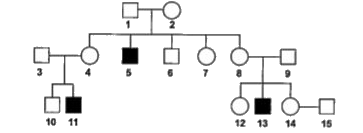Identify the correct statement :
0.1 M NaCl and 0.1 M glucose solution are isotonic
0.1 M NaCl and 0.3 M glucose solution are isotonic.
The boiling point of 0.1 m aqueous urea solution is less than 0.1 m aqueous KCl solution.
The freezing point of 0.1 m glucose solution is less than 0.1 m KCl solution.
The correct Answer is:C
To solve the question of identifying the correct statement among the given options, we will analyze each statement step by step.
Step 1: Understanding Isotonic Solutions
Isotonic solutions have the same osmotic pressure. The osmotic pressure (π) can be calculated using the formula:
π=iCRT
where:
- i = van 't Hoff factor (number of particles the solute dissociates into)
- C = concentration of the solution
- R = gas constant
- T = temperature (in Kelvin)
Step 2: Analyzing the First Statement
Statement 1: "0.1 molar NaCl solution and 0.1 molar glucose solution are isotonic."
- For NaCl:
- i=2 (Na⁺ and Cl⁻)
- C=0.1
- πNaCl=2×0.1×R×T=0.2RT
- For glucose:
- i=1 (does not dissociate)
- C=0.1
- πglucose=1×0.1×R×T=0.1RT
Since πNaCl≠πglucose, they are not isotonic. This statement is incorrect.
Step 3: Analyzing the Second Statement
Statement 2: "0.1 molar NaCl and 0.3 molar glucose solution is isotonic."
- For NaCl:
- πNaCl=2×0.1×R×T=0.2RT
- For glucose:
- i=1
- C=0.3
- πglucose=1×0.3×R×T=0.3RT
Since πNaCl≠πglucose, they are not isotonic. This statement is incorrect.
Step 4: Analyzing the Third Statement
Statement 3: "The boiling point of 0.1 molal aqueous urea solution is less than 0.1 molal aqueous KCl solution."
- For urea:
- i=1
- ΔTb=i⋅Kb⋅m=1⋅Kb⋅0.1=0.1Kb
- For KCl:
- i=2
- ΔTb=2⋅Kb⋅0.1=0.2Kb
Since ΔTb(KCl)>ΔTb(Urea), the boiling point of urea is indeed less than that of KCl. This statement is correct.
Step 5: Analyzing the Fourth Statement
Statement 4: "The freezing point of 0.1 molar glucose solution is less than 0.1 molar KCl solution."
- For glucose:
- i=1
- ΔTf=i⋅Kf⋅m=1⋅Kf⋅0.1=0.1Kf
- For KCl:
- i=2
- ΔTf=2⋅Kf⋅0.1=0.2Kf
Since ΔTf(KCl)>ΔTf(glucose), the freezing point of glucose is actually greater than that of KCl. This statement is incorrect.
Conclusion
The only correct statement among the options provided is:
The boiling point of 0.1 molal aqueous urea solution is less than 0.1 molal aqueous KCl solution.
---
Isotonic solutions have the same osmotic pressure. The osmotic pressure (π) can be calculated using the formula:
π=iCRT
where:
- i = van 't Hoff factor (number of particles the solute dissociates into)
- C = concentration of the solution
- R = gas constant
- T = temperature (in Kelvin)
Statement 1: "0.1 molar NaCl solution and 0.1 molar glucose solution are isotonic."
- i=2 (Na⁺ and Cl⁻)
- C=0.1
- πNaCl=2×0.1×R×T=0.2RT
- i=1 (does not dissociate)
- C=0.1
- πglucose=1×0.1×R×T=0.1RT
Statement 2: "0.1 molar NaCl and 0.3 molar glucose solution is isotonic."
- πNaCl=2×0.1×R×T=0.2RT
- i=1
- C=0.3
- πglucose=1×0.3×R×T=0.3RT
Statement 3: "The boiling point of 0.1 molal aqueous urea solution is less than 0.1 molal aqueous KCl solution."
- i=1
- ΔTb=i⋅Kb⋅m=1⋅Kb⋅0.1=0.1Kb
- i=2
- ΔTb=2⋅Kb⋅0.1=0.2Kb
Statement 4: "The freezing point of 0.1 molar glucose solution is less than 0.1 molar KCl solution."
- i=1
- ΔTf=i⋅Kf⋅m=1⋅Kf⋅0.1=0.1Kf
- i=2
- ΔTf=2⋅Kf⋅0.1=0.2Kf
The only correct statement among the options provided is:
The boiling point of 0.1 molal aqueous urea solution is less than 0.1 molal aqueous KCl solution.
Similar Questions
Knowledge Check
- Question 1 - Select One
The pedigree chart given below represents the pattern of inheritance of haemophilia in a family. Study it carefully and answer the following questions:

Identify the correct statement with respect to member '4':AHe is a carrier maleBShe is a carrier femaleCHe is haemophilicDShe is a homozygous female - Question 2 - Select One
Consider a Py orbital of an atom and identify correct statement
As-orbital of another atom produces π-bond when y is the bond formation axisBpy-orbital of another atom produces σ-bond when x is the bond formation axis.Cpz-orbital of another atom produces π-bond when x is the bond formation axis.Ddxy-orbital of another atom produces π-bond when x is the bond formation axis


